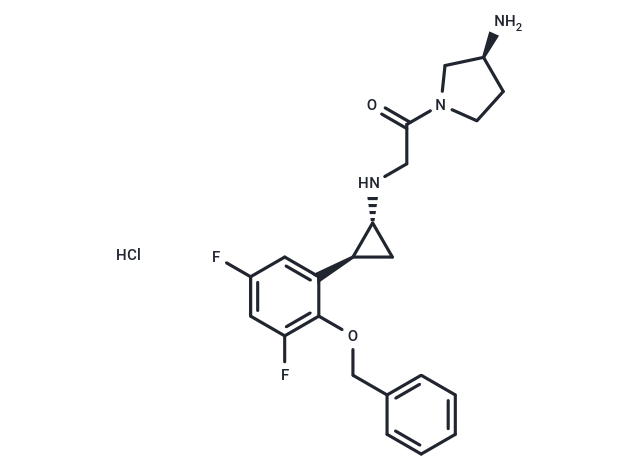Shopping Cart
Remove All Your shopping cart is currently empty
Your shopping cart is currently empty
S2116 is a powerful inhibitor of lysine-specific demethylase 1 (LSD1), and it is a derivative of N-alkylated tranylcypromine (TCP). S2116 exhibits its inhibitory effects by increasing H3K9 methylation and inducing reciprocal H3K27 deacetylation at super-enhancer regions. In TCP-resistant T-cell acute lymphoblastic leukemia (T-ALL) cells, S2116 triggers apoptosis by repressing the transcription of NOTCH3 and TAL1 genes. Furthermore, S2116 demonstrates significant growth retardation of T-ALL cells when xenotransplanted into mice.


| Description | S2116 is a powerful inhibitor of lysine-specific demethylase 1 (LSD1), and it is a derivative of N-alkylated tranylcypromine (TCP). S2116 exhibits its inhibitory effects by increasing H3K9 methylation and inducing reciprocal H3K27 deacetylation at super-enhancer regions. In TCP-resistant T-cell acute lymphoblastic leukemia (T-ALL) cells, S2116 triggers apoptosis by repressing the transcription of NOTCH3 and TAL1 genes. Furthermore, S2116 demonstrates significant growth retardation of T-ALL cells when xenotransplanted into mice. |
| In vitro | S2116 has been shown to be notably effective against T-cell acute lymphoblastic leukemia (T-ALL) cell lines, with IC50 values ranging from 1.1 μM for the CEM human T-ALL cell line to 6.8 μM for MOLT4[1]. At concentrations between 4-20 μM over 72 hours, S2116 slightly inhibits mitogen-activated normal T-lymphocytes[1]. Additionally, at lower concentrations of 4-8 μM for 24 hours, S2116 triggers apoptosis and reduces the levels of NOTCH3 and TAL1 proteins in T-ALL cells[1]. Through Cell Viability Assay on normal T-lymphocytes and Apoptosis Analysis on T-ALL cells, moderate inhibition of normal T-lymphocytes and induction of apoptosis in T-ALL cells were observed, respectively. This was supported by flow cytometry findings, showing increased annexin-V binding, indicative of apoptosis, in a dose- and time-dependent manner, without altering the cell cycle distribution. Western Blot Analysis confirmed the down-regulation of NOTCH3 and TAL1 proteins in T-ALL cells[1]. |
| In vivo | S2116 administered intraperitoneally (IP) at a dosage of 50 mg/kg, three times a week for a duration of 28 days, was found to significantly reduce the size of subcutaneous tumors in nonobese diabetic/severe combined immunodeficiency (NOD/SCID) mice implanted with MOLT4 cells to less than 20% compared to the untreated control group[1]. Additionally, pharmacokinetic analysis in 8-week-old ICR mice given the same dosage (50 mg/kg; IP) revealed a half-life (T 1/2) of 3.76 hours, a maximum concentration (C max) of 12.7 μM, and an area under the curve (AUC) of 59.2 μM?h[1], indicating the drug's specific absorption and elimination profile within the studied parameters. |
| Molecular Weight | 437.92 |
| Formula | C22H26ClF2N3O2 |
| Cas No. | 2262489-89-2 |
| Smiles | Cl.N[C@H]1CCN(C1)C(=O)CN[C@@H]1C[C@H]1c1cc(F)cc(F)c1OCc1ccccc1 |
| Storage | Powder: -20°C for 3 years | In solvent: -80°C for 1 year | Shipping with blue ice/Shipping at ambient temperature. |
| Size | Quantity | Unit Price | Amount | Operation |
|---|

Copyright © 2015-2026 TargetMol Chemicals Inc. All Rights Reserved.